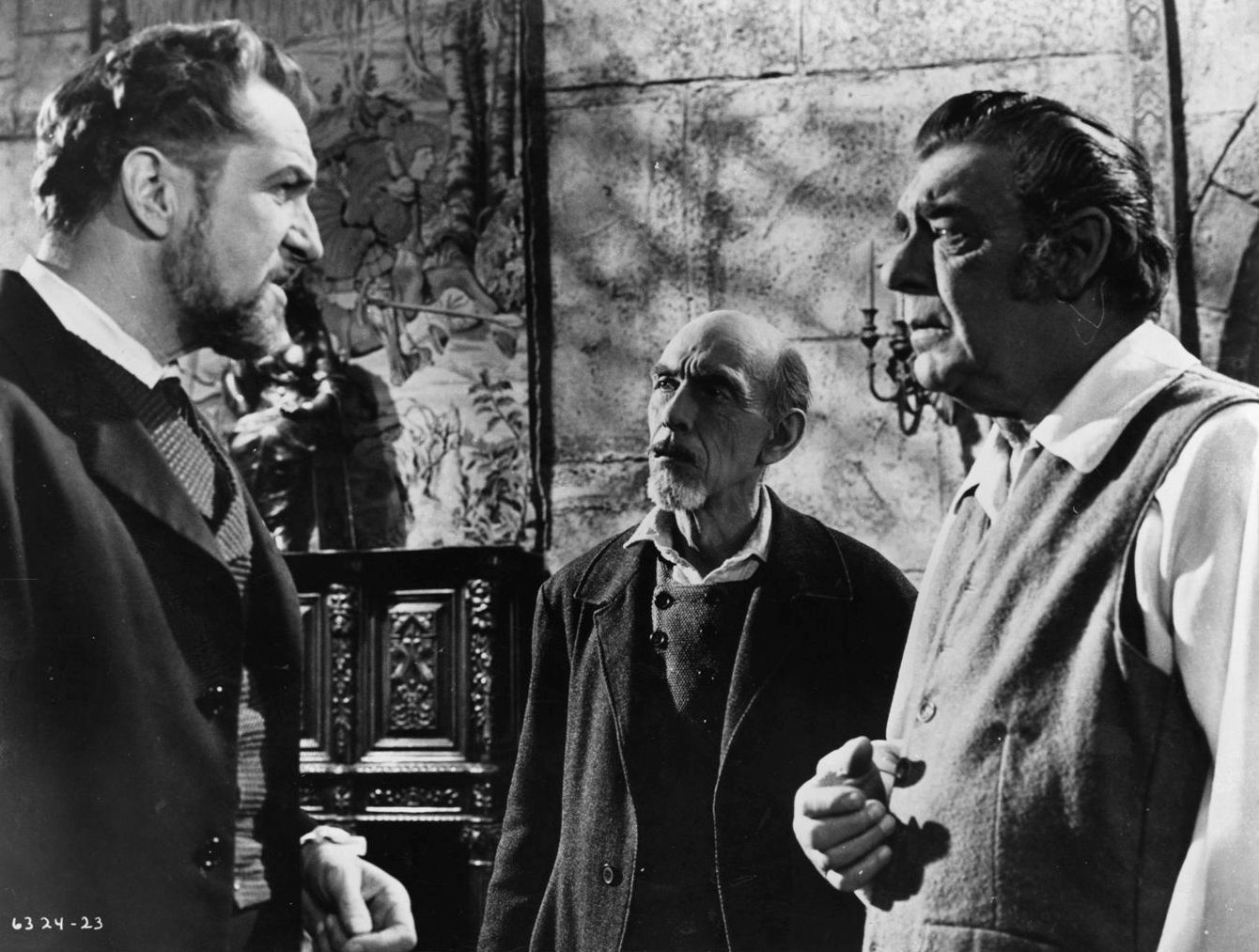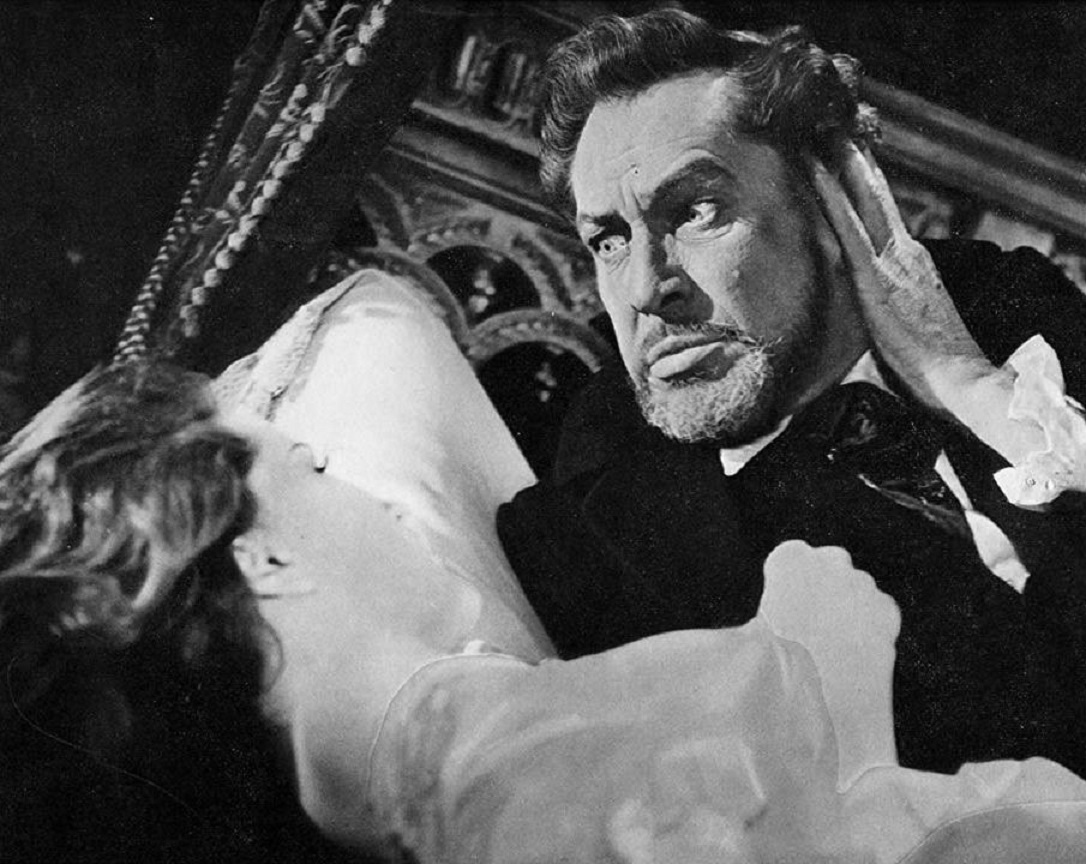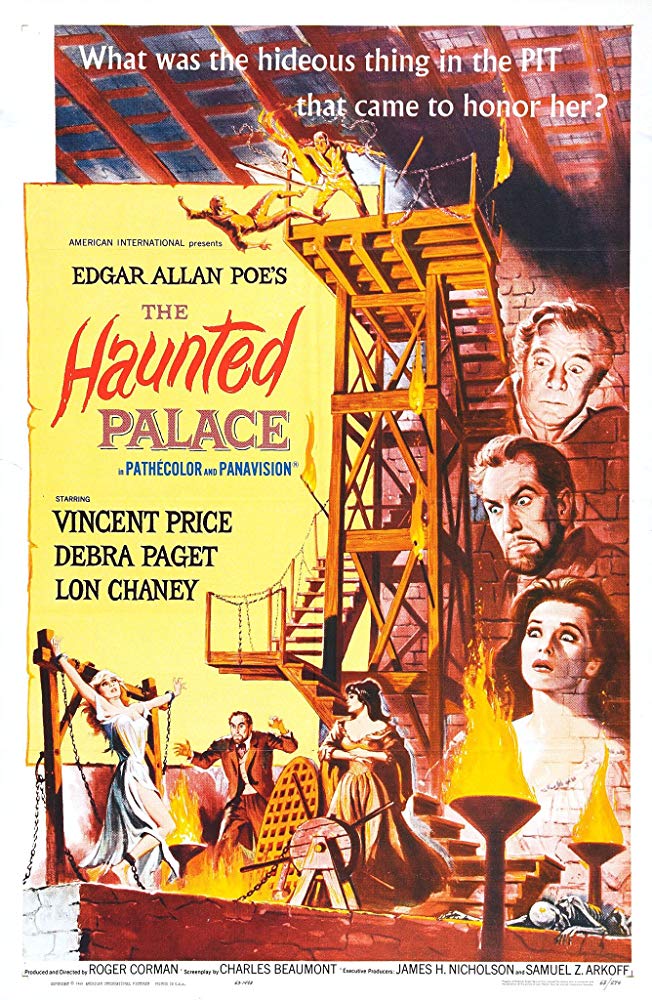USA. 1963.
Crew
Director/Producer – Roger Corman, Screenplay – Charles Beaumont, Based on the Novel The Case of Charles Dexter Ward (1941) by H.P. Lovecraft, Title Based on the Poem The Haunted Palace (1839) by Edgar Allan Poe, Photography – Floyd Crosby, Music – Ronald Stein, Makeup – Ted Coodley, Production Design – Daniel Haller. Production Company – AIP/Alta Vista.
Cast
Vincent Price (Charles Dexter Ward/Joseph Curwen), Debra Paget (Ann Ward), Frank Maxwell (Dr Willett), Lon Chaney Jr (Simon Orme), Leo Gordon (Ezra Weeden/Edgar Weeden), Elisha Cook Jr (Michas Smith/Gideon Smith)
Plot
In the small New England town of Arkham, the townspeople discover Joseph Curwen has taken a local girl and is preparing to use her in blasphemous rituals to interbreed humans with the Elder Gods, something that will allow the Gods to have dominion over the Earth again. Curwen is dragged out and burnt at the stake. He dies cursing the locals, saying that he will return to haunt their children’s children. 110 years later and Curwen’s descendant Charles Dexter Ward and his wife Ann arrive in Arkham to inherit the Curwen mansion but are afforded a frosty welcome by the locals. In the mansion, the weak Ward’s mind is taken over by the spirit of Curwen, emanating from a portrait over the mantle. Using Ward, Curwen again sets about his blasphemous mission again, while taking revenge on the descendants of those that burned him.
The Haunted Palace is often taken as one of the series of Edgar Allan Poe adaptations that Roger Corman made during the 1960s. (See below for Roger Corman’s other Edgar Allan Poe films). While the film was billed as ‘Edgar Allan Poe’s The Haunted Palace‘ and has most of the production personnel behind all of Roger Corman’s other Poe films, it is in fact based upon a novella by H.P. Lovecraft.
H.P. Lovecraft is a cult horror writer. Writing between 1922 and his death in 1937, Lovecraft created an extraordinary body of work, centred around cosmic nightmares – of ancient gods waiting beyond the abyss of time to return and wreak havoc, of blasphemous rites, abominable experiments in miscegenation and people driven insane by contact with the elder forces. Roger Corman and his team originally started out making a straight adaptation of H.P. Lovecraft’s novella The Case of Charles Dexter Ward (published posthumously in 1941) but then had the Edgar Allan Poe title forced on them by AIP who were seeking to exploit a connection with Corman’s Poe films.
The Edgar Allan Poe connection is tenuous to say the least – there is no palace in the film, nor any haunting or anything to do Poe’s 1839 mood poem, although Vincent Price gets to quote a couple of lines from it to justify the connection. What the film does trade on is the redolent, oppressive atmosphere of Roger Corman’s Poe films. As it transpires, H.P. Lovecraft and (at least the filmic) Edgar Allan Poe make strangely congruous bedfellows.

The Roger Corman production team are on good form. There is a fine brooding Ronald Stein score. Cinematographer Floyd Crosby and production designer Daniel Haller make particularly good usage of drowned-out colour contrasts – the house in muted browns, the town in greys, being strikingly lit up by the occasional flash of a red gown. The sets that Daniel Haller builds – so that Floyd Crosby can with raw effect crank the camera right up to the ceiling over the sacrificial altar, or pan through the cavernous hallway of the house – are excellent.
There is a classical elegance to Roger Corman’s direction – like the strangely ritualistic scene in the streets where the mutants surround Vincent Price and Debra Paget and move off at the tolling of a bell; or a sadistically nasty scene where Vincent Price douses Elisha Cook in fuel and then coldly tosses a match at him.
Vincent Price overdoes his familiar craven, cringing thing as Ward but the sinister smile as Curwen takes over has a potency. What The Haunted Palace principally lacks though is something to do once it has gotten its warlock back to life, thereafter only circling around cliche warlock’s revenge and sacrificial virgin plots.

Roger Corman’s other Edgar Allan Poe films are:- The House of Usher/The Fall of the House of Usher (1960), Pit and the Pendulum (1961), Premature Burial (1962), Tales of Terror (1962), The Raven (1963), The Masque of the Red Death (1964) and The Tomb of Ligeia (1964). The Case of Charles Dexter Ward was later remade by Dan O’Bannon as the also worthwhile The Resurrected (1992). This film’s production designer Daniel Haller would also go onto direct two further H.P. Lovecraft adaptations in the same style as Roger Corman’s Poe films with Die, Monster, Die/Monster of Terror (1965) and The Dunwich Horror (1969).
Roger Corman’s other genre films as director are:– Day the World Ended (1955), It Conquered the World (1956), Attack of the Crab Monsters (1957), Not Of This Earth (1957), The Saga of the Viking Women and Their Journey to the Waters of the Great Sea Serpent (1957), The Undead (1957), Teenage Caveman (1958), War of the Satellites (1958), A Bucket of Blood (1959), The Wasp Woman (1959), Last Woman on Earth (1960), The Little Shop of Horrors (1960), Creature from the Haunted Sea (1961), Tower of London (1962), The Terror (1963), X – The Man with X-Ray Eyes (1963), The Trip (1967), Gas; or It Became Necessary to Destroy the World in Order to Save It (1970) and Frankenstein Unbound (1990). Corman’s World: Exploits of a Hollywood Rebel (2011) is a documentary about Corman’s career.
Other films based on the works of H.P. Lovecraft include:- Die, Monster, Die/Monster of Terror (1965), The Shuttered Room (1967) and The Dunwich Horror (1969). The big success in the modern era was Stuart Gordon’s splattery black comedy version of Re-Animator (1985), which popularised Lovecraft on film. This led to a host of B-budget Lovecraft adaptations, including Stuart Gordon’s subsequent From Beyond (1986), The Curse (1987), The Unnameable (1988), The Resurrected (1992), Necronomicon (1993), The Unnamable II: The Statement of Randolph Carter (1993), Lurking Fear (1994), Gordon’s Dagon (2001), and other works such as The Dream-Quest of Unknown Kadath (2003), Beyond the Wall of Sleep (2006), Cool Air (2006), Chill (2007), Cthulhu (2007), The Tomb (2007), Colour from the Dark (2008), The Dunwich Horror (2009), The Color (2010), Pickman’s Muse (2010), The Whisperer in Darkness (2011), The Dark Sleep (2013), The Haunter of the Dark (2015), Herbert West: Re-Animator (2017), Color Out of Space (2019), H.P. Lovecraft’s The Deep Ones (2020), the tv series Lovecraft Country (2020), Markham (2020), H.P. Lovecraft’s Witch House (2021), The Resonator: Miskatonic U (2021), The Lurking Fear (2023), Suitable Flesh (2023), H.P. Lovecraft’s The Old Ones (2024), The Innsmouth School for Girls (2024) and Unspeakable: Beyond the Wall of Sleep (2024). Lovecraft: Fear of the Unknown (2008) is a documentary about Lovecraft. Also of interest is The Manitou (1978), which features an appearance of the Great Old One; Cast a Deadly Spell (1991) and its sequel Witch Hunt (1994), a tv movie set in an alternate world where magic works and where the central character is a detective named H.P. Lovecraft; Juan Piquer Simon’s cheap and loosely inspired Cthulhu Mansion (1992); John Carpenter’s Lovecraft homage In the Mouth of Madness (1995); the fan parodies Lovecracked: The Movie (2006), The Last Lovecraft: Relic of Cthulhu (2009) and Call Girl of Cthulhu (2014); even a trilogy of animated children’s film Howard Lovecraft and the Frozen Kingdom (2016), Howard Lovecraft and the Undersea Kingdom (2017) and Howard Lovecraft and the Kingdom of Madness (2018) in which a young Lovecraft encounters his own creations; while Batman faces Lovecraftian horrors in the animated Batman: The Doom That Came to Gotham (2023); and Lovecraft homages such as The Breach (2022), H.P. Lovecraft’s Monster Portal (2022) and Gods of the Deep (2023). The Elder Gods turn up at the end of The Cabin in the Woods (2012), Lovecraft (Paul Titley) appears as an imaginary companion in Ghostland/Incident in a Ghostland (2018) and In Search of Lovecraft (2008) features a tv news crew discovering that Lovecraft’s works are true. Lovecraft’s key work of demonic lore The Necronomicon also makes appearances in films such as Equinox (1970), The Evil Dead II (1987) and Army of Darkness (1992), and was also borrowed as an alternate retitling for Jesus Franco’s surreal and otherwise unrelated Succubus/Necronomicon (1969) about a BDSM dancer.
Trailer here


